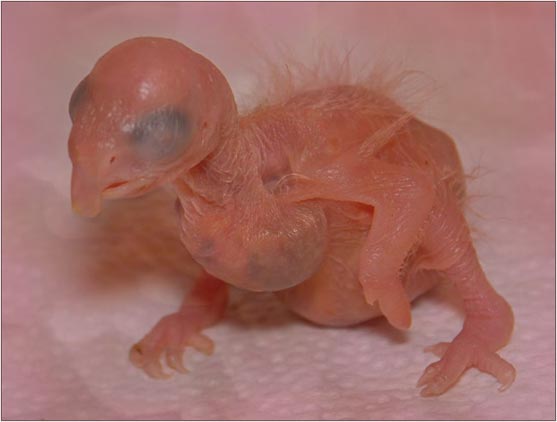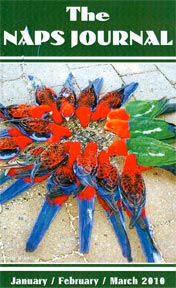|
By Susie Christian, Morro Bay, CA. |
|||||
|
|
|||||
|
During the weeks before Christmas, I spend the time giving the flights a thorough cleaning out, as well as the nest boxes. I fortunately happen to have inherited Dale’s huge, heavy Eucalyptus log nest boxes. I remove the inspection door plugs and take all the old nesting material out that might remain from the previous season. I also use a long handled cob-web duster, and run it around the sides of the interior, as far as I can reach, to clear the nests of any spider webs or spiders. Wearing gloves, I work my fingers into any crevices or corners, to get dirt or foreign objects cleared. Galahs love to find small rocks on the flight floor and haul them into their nests. I believe they use them in the nests as heat sync objects, and I don’t remove the pebbles and Eucalyptus nuts during the rest of the breeding season. After I have given the nests a good cleaning, I put a layer of about six to eight inches of Eucalyptus leaves into the nest box lower cavity. It doesn’t matter if the leaves are piled high and seem thick. The birds will always get inside and rearrange the interior. Some birds will bring more leaves in on top of my layer, and some will discard everything I put in and start over. Some years ago one young, novice pair kept layering the leaves so enthusiastically, they built it way up past the examination door. I had to keep taking the layers out so I could inspect their nest. The next year they built just the right sized layer in the box. I close the inspection door, say a prayer for rain, and plan on leaving the flights in a very quiet state for the next four to five months; the length of the Galah breeding season here. Only very minimal maintenance is done during that time, because the Galah pairs are very upset with any unusual noise and disturbance here. During the season I do a light raking of the outside area, spray the flight floor briefly, and of course if I have to enter to replace a chewed apart perch, I do that. Years back I had a young hen setting on some fertile eggs, and at Easter time some children had a noisy game of baseball going on in the lot behind, and kitty-corner from the flights. The eggs were broken in minutes, as was my heart along with them. Of course the Galahs can and will make all sorts of amazing noise among themselves, but a new and different, man-made loud noise is the worst thing that can happen during breeding season. I also purposely let the tall grasses and certain plants come up in the yard for them. Usually I get lovely wheat grass plants, and a whole variety of other greens, safe to feed the Galahs, as a result of what grows from uneaten, dumped sprouts. I offer these grasses to them in breeding season, and they eagerly watch me put it into the flights, pouncing on it and devouring it until their beaks turn green. I continue to offer them grass during the season and when they have babies I feed them grass every day. Fresh grass had a lot of chlorophyll in it, and when the babies are pulled they have bright green poop as a result of what they have been fed by the parents. Just like us going to the juice bar and drinking a cup of fresh wheat grass. Healthy stuff. The Galahs are fed very light and low fat most of the year, because they gain weight just by looking at food, but when they have babies in the nest, they get anything and everything they want. I feed a portion of soft food early in the morning, another meal of the same about noon, seed mid afternoon, and another soft food serving just before dark. This sound like a lot, but when they are feeding babies they seem frantic for food, and I don’t want to skimp where babies are concerned. The minute breeding season is over they go back on a low calorie diet. The food I give them when babies are present is sprouted seed, a cooked grain and brown rice mixture, chopped up fresh vegetables, crumbled hard boiled egg, tofu, and their favourite – frozen peas and corn served warm. In fact I serve warmed food to any parent birds here who have babies. Might be just me, but it looks like they relish the warmth of the food when there are babies to feed. I also clip a spray of millet onto the cage side when they have babies, and replace it when it gets nibbled down. In other words I feed the Galahs very sparingly during the better part of the year, but once the babies hatch, they get fed royally.
|
|||||
|
|||||
|
|
|||||


